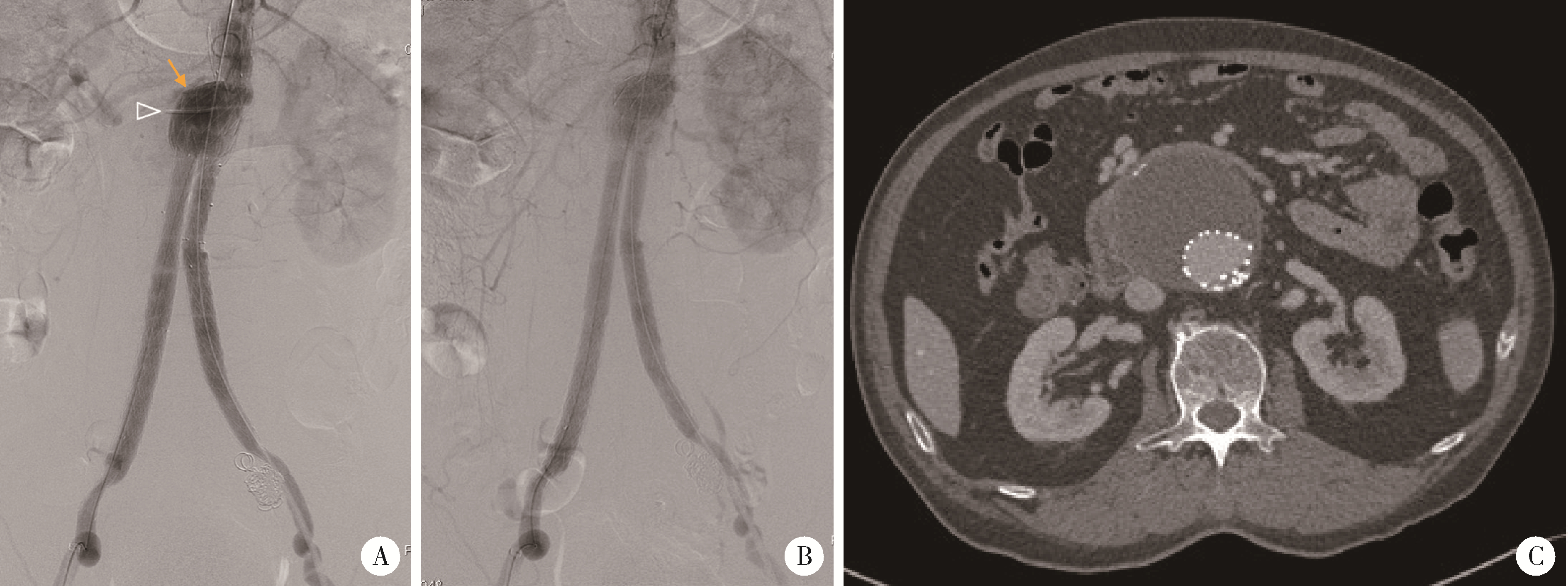Journal of Peking University (Health Sciences) ›› 2024, Vol. 56 ›› Issue (6): 1052-1057. doi: 10.19723/j.issn.1671-167X.2024.06.017
Previous Articles Next Articles
Effect of balloon occlusion combined with intra-sac injection of thrombin in the treatment of ruptured abdominal aortic aneurysm
Shilu ZHAO, Jingyuan LUAN*( ), Qichen FENG, Qijia LIU, Guangxin YANG, Zichang JIA, Jinman ZHUANG
), Qichen FENG, Qijia LIU, Guangxin YANG, Zichang JIA, Jinman ZHUANG
- Department of Interventional Radiology and Vascular Surgery, Peking University Third Hospital, Beijing 100191, China
CLC Number:
- R654.3
| 1 |
Reimerink JJ , van der Laan MJ .Systematic review and meta-analysis of population-based mortality from ruptured abdominal aortic aneurysm[J].Br J Surg,2013,100(11):1405-1413.
doi: 10.1002/bjs.9235 |
| 2 | Amato B , Fugetto F .Endovascular repair versus open repair in the treatment of ruptured aortic aneurysms: A systematic review[J].Minerva Chir,2019,74(6):472-480. |
| 3 |
Patelis N , Moris D .Endovascular vs. open repair for ruptured abdominal aortic aneurysm[J].Med Sci Monit Basic Res,2016,22,34-44.
doi: 10.12659/MSMBR.897601 |
| 4 |
McPhee J , Eslami MH .Endovascular treatment of ruptured abdominal aortic aneurysms in the United States (2001-2006): A significant survival benefit over open repair is independently associated with increased institutional volume[J].J Vasc Surg,2009,49(4):817-826.
doi: 10.1016/j.jvs.2008.11.002 |
| 5 |
Holt PJ , Karthikesalingam A .Propensity scored analysis of outcomes after ruptured abdominal aortic aneurysm[J].Br J Surg,2010,97(4):496-503.
doi: 10.1002/bjs.6911 |
| 6 |
Azhar B , Patel SR .Misdiagnosis of ruptured abdominal aortic aneurysm: Systematic review and meta-analysis[J].J Endovasc Ther,2014,21(4):568-575.
doi: 10.1583/13-4626MR.1 |
| 7 |
Rhudy AK , Patel S .Point-of-care ultrasound for identification of ruptured infrarenal abdominal aortic aneurysm[J].Echocardiography,2022,39(6):841-843.
doi: 10.1111/echo.15359 |
| 8 |
Lee KM , Choi SY .Effects of anatomical characteristics as factors in abdominal aortic aneurysm rupture: CT aortography analysis[J].Medicine (Baltimore),2017,96(25):e7236.
doi: 10.1097/MD.0000000000007236 |
| 9 |
Tadayon N , Mozafar M .In-hospital outcomes of ruptured abdominal aortic aneurysms: A single center experience[J].J Cardiovasc Thorac Res,2022,14(1):61-66.
doi: 10.34172/jcvtr.2022.02 |
| 10 |
Qin C , Chen L .Emergent endovascular vs. open surgery repair for ruptured abdominal aortic aneurysms: A meta-analysis[J].PLoS One,2014,9(1):e87465.
doi: 10.1371/journal.pone.0087465 |
| 11 | Badger S , Forster R .Endovascular treatment for ruptured abdominal aortic aneurysm[J].Cochrane Database Syst Rev,2017,26(5):CD005261. |
| 12 | Badger S , Bedenis R .Endovascular treatment for ruptured abdominal aortic aneurysm[J].Cochrane Database Syst Rev,2014,21(7):CD005261. |
| 13 |
Ciaramella MA , Ventarola D .Modern mortality risk stratification scores accurately and equally predict real-world postoperative mortality after ruptured abdominal aortic aneurysm[J].J Vasc Surg,2021,73(3):1048-1055.
doi: 10.1016/j.jvs.2020.07.058 |
| 14 |
Philipsen TE , Hendriks JM .The use of rapid endovascular balloon occlusion in unstable patients with ruptured abdominal aortic aneurysm[J].Innovations (Phila),2009,4(2):74-79.
doi: 10.1097/imi.0b013e3181a00bc9 |
| 15 |
Farooq MM , Freischlag JA .Effect of the duration of symptoms, transport time, and length of emergency room stay on morbidity and mortality in patients with ruptured abdominal aortic aneurysms[J].Surgery,1996,119(1):9-14.
doi: 10.1016/S0039-6060(96)80206-6 |
| 16 |
Raux M , Marzelle J .Endovascular balloon occlusion is associated with reduced intraoperative mortality of unstable patients with ruptured abdominal aortic aneurysm but fails to improve other outcomes[J].J Vasc Surg,2015,61(2):304-308.
doi: 10.1016/j.jvs.2014.07.098 |
| 17 |
Bath J , Leite JO .Contemporary outcomes for ruptured abdominal aortic aneurysms using endovascular balloon control for hypotension[J].J Vasc Surg,2018,67(5):1389-1396.
doi: 10.1016/j.jvs.2017.09.031 |
| 18 |
Zhao SL , Xiong JP .Intra-sac injection of thrombin during endovascular aneurysm repair to remedy type Ⅱ endoleak and promote sac shrinkage[J].Vasc Endovascular Surg,2024,58(2):151-157.
doi: 10.1177/15385744231197457 |
| 19 |
Rubenstein C , Bietz G , Davenport DL , et al.Abdominal compartment syndrome associated with endovascular and open repair of ruptured abdominal aortic aneurysms[J].J Vasc Surg,2015,61(3):648-654.
doi: 10.1016/j.jvs.2014.10.011 |
| [1] | Zhong-qiang YAO,Chang-hong LI,Xin-yi LI,Wei GUO,Jia-yu ZHAI,Rui LIU,Hui WEI,Rong MU. Correlation of anti-phosphatidylserine/prothrombin antibodies with unexplained recurrent miscarriages [J]. Journal of Peking University (Health Sciences), 2023, 55(6): 1058-1061. |
| [2] | Li-rong HONG,Yu-jia CHEN,Qing-lai JIANG,Ru-lin JIA,Chun LI,Liang-hua FENG. Predictive value of four items of new thrombus markers combined with conventional coagulation tests for thrombosis in antiphospholipid syndrome [J]. Journal of Peking University (Health Sciences), 2023, 55(6): 1033-1038. |
| [3] | ZENG Hong, WANG Yan, WANG Yang, GUO Xiang-yang. Perioperative management of abdominal aortic balloon occlusion in patients complicated with placenta percteta: a case report [J]. Journal of Peking University(Health Sciences), 2015, 47(6): 1031-1033. |
|
||



